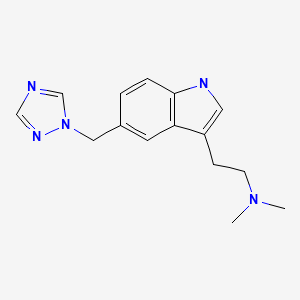Attribution Statement: LactMed is a registered trademark of the U.S. Department of Health and Human Services.
NCBI Bookshelf. A service of the National Library of Medicine, National Institutes of Health.
Drugs and Lactation Database (LactMed®) [Internet]. Bethesda (MD): National Institute of Child Health and Human Development; 2006-.
CASRN: 144034-80-0

Drug Levels and Effects
Summary of Use during Lactation
Breastmilk levels of rizatriptan are low and the half-life in milk is relatively short. Amounts ingested by the infant are small and unlikely to affect the nursing infant. Painful, burning nipples and breast pain have been reported after doses of sumatriptan and other triptans. This has occasionally been accompanied by a decrease in milk production.
Drug Levels
Maternal Levels. Five women who were at least 1 month postpartum and used rizatriptan to treat migraine provided one milk sample before their dose, then additional milk samples at 1, 2, 4, 8, 12 and 24 hours after their 10 mg oral dose. The average peak milk level was 58.4 mcg/L (range 14.6 to 105.6 mcg/L) and occurred 2 hours after the dose in 4 women ad 4 hours after the dose in another. The average milk level was 9 mcg/L (range 2.6 to 14.8 mcg/L) and the average half-life in milk was 2.2 hours (range 1.6 to 3.1 hours). The average daily infant dosage of rizatriptan was 1.3 mcg/kg (range 0.4 to 2.2 mcg/kg) and the weight-adjusted infant dosage averaged 0.9% (range 0.5 to 1.4%) of the maternal dose.[1]
Infant Levels. Relevant published information was not found as of the revision date.
Effects in Breastfed Infants
Relevant published information was not found as of the revision date.
Effects on Lactation and Breastmilk
A review of four European adverse reaction databases found 26 reported cases of, painful, burning nipples, painful breasts, breast engorgement and/or painful milk ejection in women who took a triptan while nursing. Pain was sometimes intense and occasionally led to decreased milk production. Pain generally subsided with time as the drug was eliminated. The authors proposed that triptans may cause vasoconstriction of the arteries in the breast, nipples, and the arteries surrounding the alveoli and milk ducts, causing a painful sensation and a painful milk ejection reflex.[2]
Alternate Drugs to Consider
References
- 1.
- Amundsen S, Nordeng H, Fuskevåg OM, et al. Transfer of triptans into human breast milk and estimation of infant drug exposure through breastfeeding. Basic Clin Pharmacol Toxicol 2021;128:795-804. [PubMed: 33730376]
- 2.
- Conijn M, Maas V, van Tuyl M, et al. Breastfeeding-related adverse drug reactions of triptans: A descriptive analysis using four pharmacovigilance databases. Breastfeed Med 2024;19:645-51. [PubMed: 38563407]
Substance Identification
Substance Name
Rizatriptan
CAS Registry Number
144034-80-0
Drug Class
Breast Feeding
Lactation
Milk, Human
Serotonin Receptor Agonists
Serotonin 5-HT1 Receptor Agonists
Triptans
Vasoconstrictor Agents
Disclaimer: Information presented in this database is not meant as a substitute for professional judgment. You should consult your healthcare provider for breastfeeding advice related to your particular situation. The U.S. government does not warrant or assume any liability or responsibility for the accuracy or completeness of the information on this Site.
- User and Medical Advice Disclaimer
- Drugs and Lactation Database (LactMed) - Record Format
- LactMed - Database Creation and Peer Review Process
- Fact Sheet. Drugs and Lactation Database (LactMed)
- Drugs and Lactation Database (LactMed) - Glossary
- LactMed Selected References
- Drugs and Lactation Database (LactMed) - About Dietary Supplements
- Breastfeeding Links
- PubChem SubstanceRelated PubChem Substances
- PubMedLinks to PubMed
- Review Zolmitriptan.[Drugs and Lactation Database (...]Review Zolmitriptan.. Drugs and Lactation Database (LactMed®). 2006
- Review Sumatriptan.[Drugs and Lactation Database (...]Review Sumatriptan.. Drugs and Lactation Database (LactMed®). 2006
- Review Almotriptan.[Drugs and Lactation Database (...]Review Almotriptan.. Drugs and Lactation Database (LactMed®). 2006
- Review Naratriptan.[Drugs and Lactation Database (...]Review Naratriptan.. Drugs and Lactation Database (LactMed®). 2006
- 5-HT1D receptor agonists and human coronary artery reactivity in vitro: crossover comparisons of 5-HT and sumatriptan with rizatriptan and L-741,519.[Br J Clin Pharmacol. 1996]5-HT1D receptor agonists and human coronary artery reactivity in vitro: crossover comparisons of 5-HT and sumatriptan with rizatriptan and L-741,519.Longmore J, Boulanger CM, Desta B, Hill RG, Schofield WN, Taylor AA. Br J Clin Pharmacol. 1996 Oct; 42(4):431-41.
- Rizatriptan - Drugs and Lactation Database (LactMed®)Rizatriptan - Drugs and Lactation Database (LactMed®)
Your browsing activity is empty.
Activity recording is turned off.
See more...
